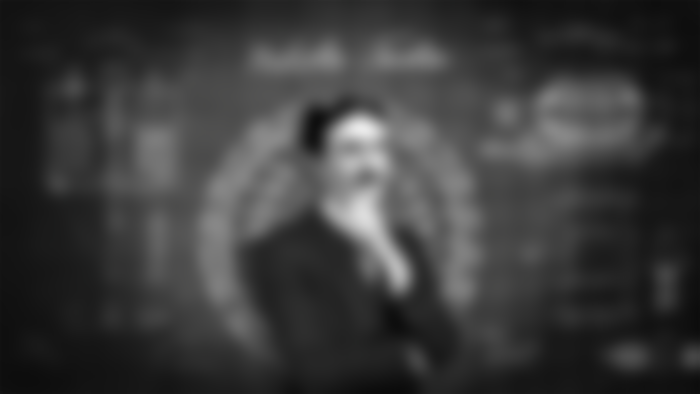Nikola Tesla a genius ?
With its incomprehensible claims, ideas that are pregnant with great discoveries, obsessions, successes, failures, but most of all, with countless claims and conspiracy theories in which the main character is himself, he attracts people's attention and allows us to step into his life story in a way; Let's get to know the inventor, electrical engineer, mechanical engineer and futurist Nikola Tesla a little more closely.
It is extremely difficult to remain impartial and completely factual, whether writing or reading about Tesla. Any source you draw on may make you a Tesla fanatic who can see lightning flash before your eyes, while another source may be hugely disappointed with it.

The bottomless adventure of science, scattered in the emptiness of space, which Tesla was always curious about; It begins when he was born on July 10, 1856, in a town in Croatia, as the fourth child of a family of five children. Despite his father, who wanted to raise his son as a religious man like himself; His mother had endowed Tesla with his inventive mind and supported him in developing fields such as physics and mathematics.
With the advantage of having a strong memory just like her mother, her ability to store everything she read and see in her extraordinary mental memory is on the lips of many people. Tesla was a bright student in high school, and his interest in physics and mathematics began to increase day by day.
He completed his education in three years, then his life was interrupted for a while with the cholera disease he caught in 1873. He soon ran away from home due to his compulsory military service and threw himself into a more free and peaceful life. It was during this period that he met the works of Mark Twain, whom he admired. In his later years, he would have the opportunity to meet Mark Twain personally and even establish a close friendship.
In 1875 he started the Polytechnic school in Graz. He continued his success as in his previous student years. However, the end of the thread seemed a little off. He studied more than a normal student, slept much less than a normal person would need. So much so that he continued to do this all his life, enough to cause him to have seizures because he slept so little. However, the scholarship he lost in his second year of school and the gambling pit he became involved in cast a shadow over Tesla's bright student life.
He could not complete his schooling and could not return to his family. Thus, he completely ended his relationship with the house where he was born, which formed the basis of his various obsessions and psychological problems, in 1878. He could not hold on to Prague University, which he started in 1880, after his father's death, and he was taking a step into a new life while his student life was over.
His career took off when he moved to Budapest in 1881 to work for the telegraph company, the Budapest Telephone Exchange, which was still under construction. He started the company as an electrical engineer, also worked as a draftsman and made the company functional. He has increased his position with his success in the company where he contributed in many developments.
Subsequently, he was awarded a new job by Tivadar Puskás, for whom he worked. He was working for the Continental Edison Company, now located in Paris. The opportunity to develop and gain experience in the field of electrical engineering made him realize his talent.
He began designing dynamo engines and built the first examples, but had no one to support him financially. Unaware that he would encounter this situation again and again in his later life, he turned to the job offer he received from New York. In 1884, he had started working for Thomas Edison at Edison Machine Works. This is where the famous Edison-Tesla feuds and the $50,000 promise event took place.
Edison, who respected his knowledge and working discipline, and the biggest disagreement between the two during the period he worked with was undoubtedly on alternating current and direct current. While Edison was defending the direct current that he was working on and that enables it to deliver electricity to homes; Tesla advocated alternating current, which he believed would operate more efficiently than direct current.
This conflict of the two ended with Tesla parting ways. Later, Tesla invented the alternating current induction motor at the center of his own ideas. With this invention, which he justified his arguments, he made an invention that enables them to obtain electrical energy more efficiently and to transmit it farther with less expense. Of course, this wasn't Tesla's only success. His mind was like an ocean floating outdated ideas.
This work, which aims to deliver wireless electricity to cities, is Tesla's best-known work. When we enter the story of a success and failure that follows; The Tesla Coil, which he patented in 1891, transmitted electricity over a short distance. Wireless transmission of electricity was an exciting invention. Tesla, who was now obsessed with wirelessly transmitted energy, would have bigger plans in the next step.
Wardenclyffe Tower was his biggest dream. For this work, which is basically a huge model of the Tesla Coil, a huge tower was built using coils at a height of meters and a diameter of 15 meters. If everything were to work according to the plans in Tesla's mind, this tower would be able to carry an incalculable amount of electricity many kilometers away and finally give humanity wireless electricity.
This is where the failures started. In a world where even wired electricity was considered a great blessing, pursuing wireless electricity and trying to achieve it with extremely weak foundations and unsound foundations was now revealing Tesla's evolution from science to a passionate dreamer. This study was disappointing from the very beginning and was at the top of the list of works that were not completed due to the withdrawal of the investors with their pockets burning.
While some sources put all the responsibility on the investors who do not make the necessary investment and do not provide the opportunity, some sources claim that the world is not ready for such an outdated invention and remains in the shadow of capitalism. However, studies examined from a realistic point of view today show that; The Wardenclyffe Tower is simply a failed study.
As stated earlier, Tesla's mind was a vast ocean, and in the depths of this ocean; lay great ideas, studies and passions. A few of them are:
Tesla Turbine: Compared to the piston engines used from those times until today, the Tesla Turbine provided more efficient fuel consumption. However, forgetting that he is not a capitalist businessman, Tesla learned later that this work would not be accepted.
Remote Control: In 1898, Tesla gave people a surprising and quite intriguing demonstration. Standing in a pond in Madison Square Garden, he remotely controlled the one-metre ship. He called this invention the Teleautomaton.
Shadowgraph: Inspired by Wilhelm Conrad Röntgen's X-ray studies, he invented his own X-ray machine, the Shadowgraph, which proved its success by first taking an X-ray of his foot.
Radio: The patent of the radio, whose original inventor is still being debated, belongs to Tesla today. Since the patent for the important foundations used in the invention of the radio belongs to Tesla, it does not seem wrong to show Tesla as the inventor of the radio.
With his unorthodox idealism, his stance completely against the businessman portrait of many inventors, and his exciting outdated ideas, Tesla has undoubtedly always been a curious and respected scientist. His supporters, who today claim him not only with his great achievements, but also with his strange obsessions and preposterous claims, were unfortunately not with him with such strong feelings when he was alive.
He was alone in his room at the New Yorker Hotel on January 7, 1943, when he died of heart failure. However, he did not complain much about his loneliness. The important thing for him was hard work, new ideas. It is possible to understand Tesla, who does not allow the slightest roughness in his life to undermine his work, with these words: "Be alone. The secret of discovery is being alone. Only when you are alone can you come up with new ideas.”
Now, the number of those who try to understand and support him is quite high. Perhaps what we need most these days is Tesla ethics; striving for social gain that precedes individual gain. The Tesla love that overflows from people is very likely to derive its source from this character stripped of individuality.
